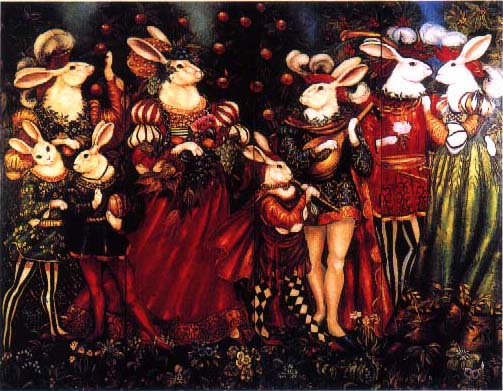|
WEST COAST DECORATIVE PAINTERS
Traditional Disciplines Applied with Contemporary Spirit
By Hunter Drohojowska
© Architectural Digest, May 1991
Page 2
Kariya's
application of Western technique to Eastern form is partly the
result of her education.
She studied in
Japan and Italy before getting her bachelor's degree from the University
of California, Berkeley, and her master's degree from the San Francisco
Art Institute. She points out that decorative art is a field where
women have excelled. "It seemed a natural thing to do."
Kariya,
who lives in Berkeley, began painting furniture in 1976 and shared
a studio with Pamela Silin-Palmer, an artist who had begun decorative
painting the year before. Silin-Palmer decided to call their joint
studio Faunus. "I named it after the Roman word for Pan because
a lot of the characters I was portraying were mythological," explains
Silin-Palmer.

ABOVE:
Pamela Silin-Palmer's fanciful autumn pageant of rabbits
in Renaissance attire,
suggested by a Botticelli painting, exemplifies what she
describes as their "iconlike quality."
|
Silin-Palmer,
who has since moved to Mendocino, has been influenced by the decorative
arts of Europe. Fantasy and
wit characterize her painted furniture and murals. She studied
art history at Yale, with a specialization in the medieval and
early Renaissance periods, but insists that most of her training
came from living in Florence and southern France, studying the
painting and the decorative arts of these regions, and teaching
herself the necessary skills. "In Europe," she says, "there isn't
as great a division between fine art and decoration."
She cites Botticelli and Uccello as having
affected her dramatic compositions and lighting. For example, an
autumn festival scene by Botticelli has inspired murals and screens
that depict Renaissance celebrations with rabbits in fancy dress
impersonating maidens, musicians and courtiers.
"I use rabbits because they have this iconlike
quality and you can project onto their faces," says Silin-Palmer
with a laugh. "And they have these incredible ears, which serve
the horizontal or diagonal in composition." She has painted a variety
of furniture with such animals as geese, sheep and pigs in Renaissance
costume, and notes that animals in human attire have been a consistent
motif in the history of decorative arts.
|